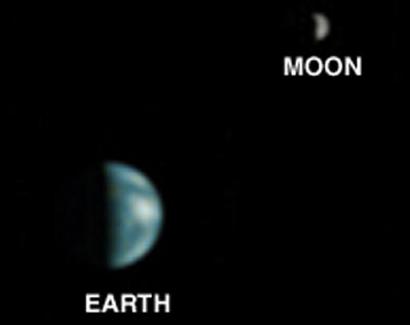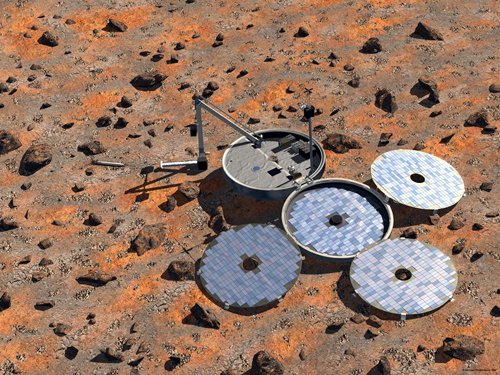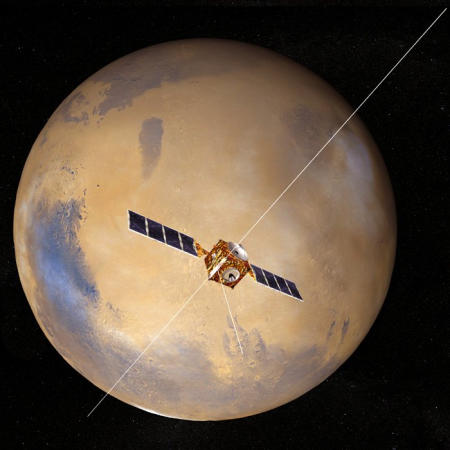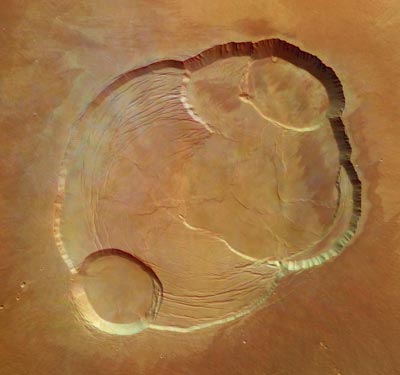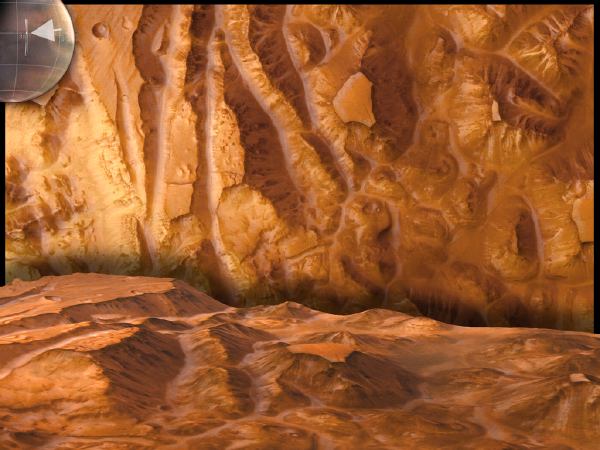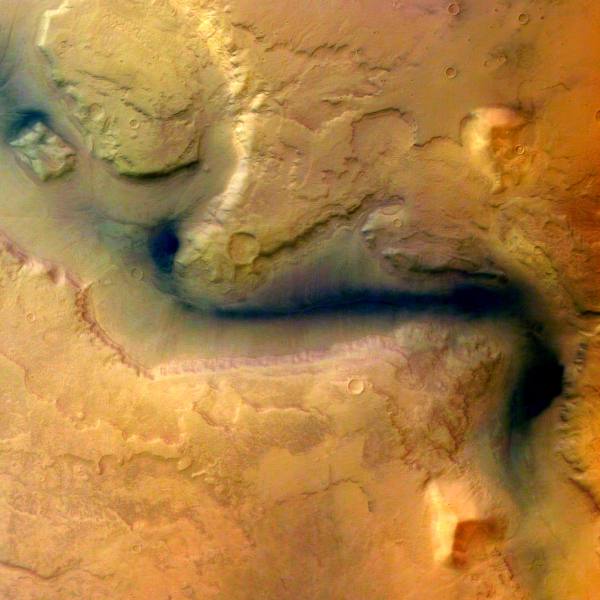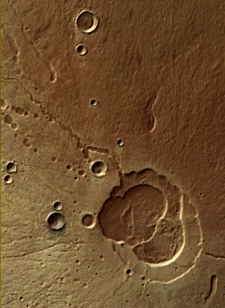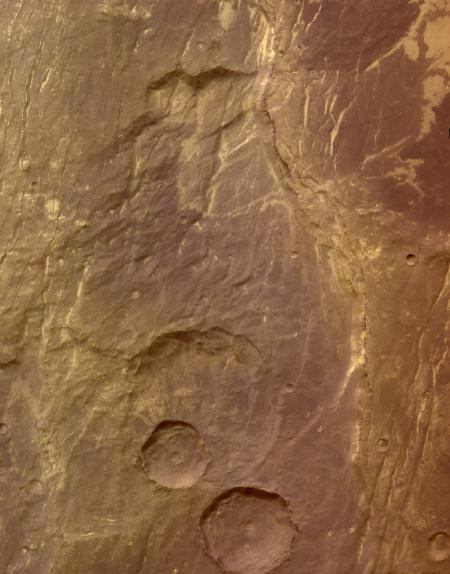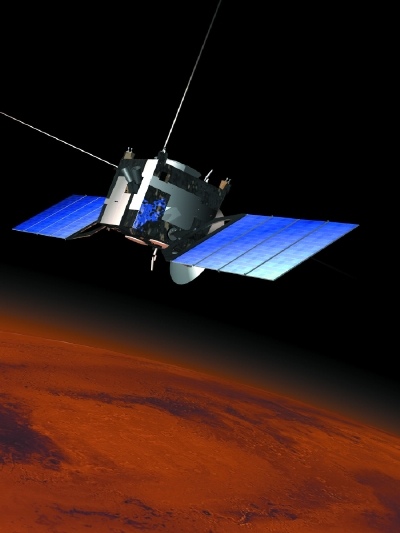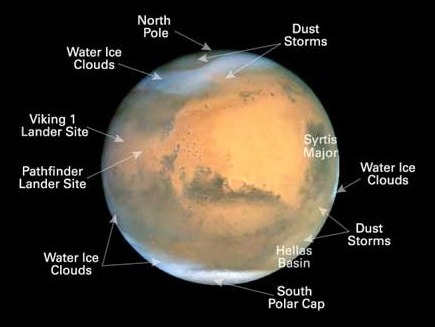Current Events at Mars
» November 30, 2005: The MARSIS radar on board Mars Express has suggested the possibility of deep underground water ice on the Red Planet. MARSIS is short for Mars Advanced Radar for Subsurface and Ionospheric Sounding. Previously, the area beneath the surface of Mars had been unexplored. But, in summer 2005, MARSIS revealed a 155-mile-wide circular structure at a depth of 0.9 to 1.5 miles under the surface of the northern lowlands in the Chryse Planitia region at Mars' mid-latitudes. Scientists have interpreted the structure as a buried impact basin. They wonder if it could contain a thick layer of water ice. Could there be other hidden impact craters elsewhere on the planet?
At the same time, the OMEGA instrument aboard Mars Express has found indications that substantial quantities of liquid water may have been present on the early Mars. OMEGA is short for Observatoire pour la Mineralogy, l'Eau, les Glaces et l'Activité – a visible and infrared mapping spectrometer.
Scientists have suggested that clay-rich phyllosilicate deposits uncovered by OMEGA may have been formed by alteration of surface materials in the very earliest times of Mars. The altered material then may have been buried by subsequent lava flows. Later, the buried material may have been exposed by erosion or excavated by meteorite impacts.
The clays probably formed during an intense cratering period in Mars' early history known as the Noachian Era. That time period lasted from from the planet's birth around 4.5 billion years ago to about 3.8 billion years ago. The Noachian era is the first and most ancient of the three geological eras on Mars.
An active hydrological system must have been present on ancient Mars to account for the large amounts of clays that OMEGA observed. The long-term contact with liquid water that led to the clay formation could have happened in a warm climate on the surface of Mars. On the other hand, the clays could have been formed by the action of water in a warm, thin crust. The sulphate deposits spotted by OMEGA would have been formed after the clays. Sulphates do not have to be in liquid water for a very long time, although water must be there and it must be acidic.
Picture: Mars Express evidence for large aquifers on early Mars »
» February 25, 2005: The Mars Express high-resolution stereo camera has photographed water ice, glaciers, dust and volcanoes at the planet's north pole. Cliffs more than a mile high encompass fields of dark volcanic ash. Scientists wonder if the fields of volcanic cones, up to 1,800 feet tall, indicate very recent volcanic activity.
Picture: north pole ice and dust »
» February 23, 2005: Using its high-resolution stereo camera, Mars Express has recorded evidence of a five-million-year-old frozen sea near the planet's equator. Looking something like an Antarctic ice pack on Earth, the flat dust-covered plain, Elysium Planum, has an average depth of about 150 feet. Similar in size to Earth's North Sea, the Martian sea measures about 500 by 560 miles. The plain is covered with irregular blocky shapes that look like rafts of fragmented ice off the coast of Antarctica on Earth. The Elysium Planum ice is prevented from evaporating by a covering layer of volcanic ash. Meanwhile, the Planetary Fourier Spectrometer aboard Mars Express has reported methane and water vapor in the atmosphere above Elysium Planum. That may be a sign of life if the methane has been produced by a biological process in liquid water under the ice.
Picture: frozen sea »
» January 5, 2005: Mars Express, ESA¹s first mission to Mars, has been working in orbit around the Red Planet for a year. It arrived there December 25, 2003, and switched on its first science instrument on January 5, 2004. The spacecraft settled into its final Mars orbit on January 28, 2004. Since then, Mars Express has been producing stunning results.
- One of the missions priorities was the discovery of water in one of its chemical states. OMEGA, the combined camera and infrared spectrometer aboard Mars Express, found it in the planet's south polar ice cap on January 18.
- That water ice and carbon dioxide ice was confirmed by PFS, a high-resolution spectrometer, which also revealed the carbon oxide distribution is different in the northern and southern hemispheres of Mars.
- The MaRS radio transmitter and receiver emitted its first signal on January 21. That transmission was reflected and scattered from the surface of Mars and then received on Earth by a 230-ft.-wide dish antenna in Australia. That measurement technique is used by scientists to see the chemical composition of Mars' atmosphere, ionosphere and surface.
- ASPERA, a plasma and energetic neutral atoms analyzer that checks whether solar wind erosion led to the present lack of water on Mars, found a difference between the impact of the solar wind area and a measurement in the tail of Mars.
- The SPICAM, an ultraviolet and infrared spectrometer, simultaneously measured the distribution of ozone and water vapor and discovered there is more water vapour where there is less ozone.
- The High Resolution Stereo Camera (HRSC) provided the most visual excitement during Mars Express' first year over the Red Planet. The camera recorded the longest swath – up to 250 miles – and largest area in combination with high resolution ever taken in the exploration of the Solar System. That made it possible to print out a picture 80 ft. long by 4 ft. high.
Picture: World's Largest Postcard »
» December 22, 2004:
The walls of Candor Chasma, one of the largest canyons in the Valles Marineris system. Traces of erosion in the canyon walls is similar to erosion in arid or alpine regions of Earth.
Picture: Candor Chasma »
» November 17, 2004:
Coprates Catena, in the southern part of the Valles Marineris canyon system, is a chain of collapsed structures parallel to the main valley Coprates Chasma. The structures vary between 1.5 and 2 miles deep. That is a good deal less than the depth of the main valley at 5 miles deep.
Picture: Coprates Catena »
» November 11, 2004:
An image of the Martian moon Phobos recorded by the High Resolution Stereo Camera (HRSC) on Mars Express is Europe¹s highest-resolution picture so far of the Red Planet's natural satellite. The image of the side of the moon facing Mars was taken from a distance of less than 125 miles with a resolution of about 23 feet per pixel. Mars Express periodically passes near Phobos as it swoops close to the Martian surface, just above the atmosphere. The orbiting spacecraft turns away from the surface of Mars for a moment to train its camera on Phobos.
Picture: Phobos »
» November 3, 2004:
ithonium Chasma and Ius Chasma in the western end of Valles Marineris, a giant canyon 2,500 miles long, up to 150 miles wide and up to 4 miles deep. The canyon system is one of the major keys to the tectonic and volcanic history of Mars and the Valles Marineris region is one of the most studied areas on the planet.
Picture: Tithonium Chasma »
» June 2004:
Crater Hale on the the northern rim of the Argyre basin in the southern hemisphere of Mars.
Picture: Crater Hale »
» June 2004:
The eastern rim of the Martian impact crater Huygens, an impact structure, about 280 miles wide, in the southern highlands of Mars. Counting craters counts on the rim indicates that Huygens Crater is almost 4000 million years old. That means the basin was formed in the early history of Mars and underwent heavy bombardment during the first 500 million years of the planet¹s lifetime.
Picture: Huygens Crater »
» June 2004:
Claritas Fossae tectonic grabens on the Solis Planum plains. The smooth plain is peppered with impact craters and material excavated from the craters. A graben forms when a block of a planet¹s crust drops down between two faults. Grabens are often seen together horsts, which are upthrown blocks lying between two steep-angled fault blocks.
Picture: Claritas Fossae grabens »
» May 2004:
The channels of Reull Vallis in the southern hemisphere of Mars. Reull Vallis is an outflow channel that extends more than 900 miles across Promethei Terra in the direction of Hellas Basin. It is some 12 miles wide and has cut more than a mile down into the surrounding plain.
Picture: Reull Vallis »
» May 2004:
The smooth surface of the Promethei Terra in the southern highlands of Mars is caused by a thick layer of dust or volcanic ash that has covered all landforms. Even young impact craters have lost their contours due to in-fill and collapse of their fragile crater walls. This layer has been removed by the wind at some ridges and crater walls.
Picture: Promethei Terra »
» May 24, 2004: British scientists want to send another Beagle lander to Mars, in 2007. The first British lander – known as Beagle 2 – had been transported to Mars piggyback on the European Space Agency's Mars Express orbiter. Unfortunately, Beagle 2 disappeared as it descended to the martian surface on December 25, 2003. It has not been heard from since, despite attempts by Mars orbiters and radiotelescopes on Earth to pick up Beagle's radio signals, and attempts from orbit above Mars to photograph the lander on the surface. The Beagle 2 lander was the conception of Colin Pillinger, professor of planetary sciences, and others at the Open University in Great Britain. He named it Beagle after the ship in which Charles Darwin formulated his ideas about evolution while sailing around the world in the 1830s. Beagle 2 was intended to settle some of the questions about whether life ever existed on the Red Planet. Lessons learned from the failed Beagle 2 flight will lead to improvements in Beagle 3, including a transmitter for tracking the lander as it descends and reception of that radio signal by a Mars satellite. Other changes would place the radio antenna on the outside of the lander and use of a shock-reducing airbag that would not bounce. During the planned Beagle 2 landing sequence, the lander would have been upside down and folded in when it touched down. After landing, a lid was to have opened and solar arrays were to have folded out, and only then would the communications antenna have been exposed for transmitting. A Beagle 3 flight in 2007 would precede two rover missions in 2009 carrying instruments similar to Beagle's.
Picture: British artist concept of Beagle 2 on Mars »
» April 2004:
Ophir Chasma is a northern part of the Valles Marineris, a huge canyon 2,500 miles long, up to 150 miles wide and up to 4 miles deep.
Picture: Ophir Chasma »
» April 21, 2004: Olympus Mons is an extraordinarily tall mountain. In fact, it is more than 16 miles tall. At about 88,000 feet in height, it is the highest volcano in our Solar System. Olympus Mons is so big that, if it were on Earth, its base would cover the entire state of New Mexico. Olympus Mons is three times as tall as the highest point on Earth, which is Mt. Everest. The volcano appears to have been dormant for eons. Olympus Mons is positioned in the Tharsis region of the Red Planet's western hemisphere. The Mars Express spacecraft, flying 170 miles overhead, photographed the western flank of the volcano. The steep slope on the flank at lower left is more than four miles above the martian plain. The broad plains west of the slope, at the top of the photo, are called aureole, from the Latin word for "circle of light." Aureole scenes north and west of the volcano feature gigantic ridges and blocks extending out more than 600 miles from the summit like flower petals. They may be the result of landslides or moving glaciers.
Picture: Olympus Mons aureole »
Picture: Olympus Mons caldera »
Picture: Olympus Mons on the plain »
» March 31, 2004: From 170 miles overhead, Mars Express used its High Resolution Stereo Camera (HRSC) to photograph an area of Mars known as Claritas Fossae on Mars – an ancient deformed area in the crust of Mars west of Solis Planum, which itself is a deformed area with volcanos southeast of a group of volcanos called Tharsis.
Picture: Claritas Fossae region of Mars »
» March 30, 2004: Mars Express has seen methane in the martian atmosphere. The methane was found by the Planetary Fourier Spectrometer (PFS), which detects molecules by analyzing their spectral fingerprints. Those fingerprints are measures of the way molecules absorb sunlight.
The amount of methane in the martian atmosphere is very small – about 10 parts in a billion. Scientists are wondering how the methane is generated. The gas may survive in the atmosphere only a few hundreds of years because it turns quickly to water and carbon dioxide. That tells scientists there must be some way the methane in the atmosphere is replenished.
Considering what happens on Earth, methane production on Mars might be linked to volcanos or water and steam trapped in fractured and porous rocks. On Earth, hydrothermal fluids are found from several hundred feet to several miles below the surface.
Alternatively, methane on Earth also is a by-product of biological activity, such as fermentation. That brings up the possibility of life. Biological sources of methane on Earth include fermentation in ruminant animals, anaerobic decay of organic material in rice paddies, and natural wetlands.
The orbiter is designed to study the chemical composition of the atmosphere, which is 95 percent percent carbon dioxide and 5 percent other gases. European scientists expect Mars Express to find oxygen, water, carbon monoxide and formaldehyde in the atmosphere. Those gases could tell a story about the presence of life at sometime in the past or present on the Red Planet.
Picture: an artist's idea of Mars Express in orbit »
» March 8, 2004: Europe's lost lander, Beagle 2, may or may not have turned up in an orbiter photo of the surface of the Red Planet. The British-built Mars lander had been transported to Mars piggyback on the Mars Express orbiter. Beagle 2 disappeared as it descended to the martian surface on December 25, 2003. It has not been heard from since, despite attempts to pick up its radio signals by Mars orbiters and radiotelescopes on Earth. The photograph of the area where Beagle 2 should have landed has been described as showing four bright spots, which some hope may be the remains of the lander's parachute and air bags. Others say the picture is not conclusive. Beagle 2 had been intended for a landing on Isidis Planitia, a countryside said to have some hills and craters, which could have made a safe landing difficult.
Picture: ESA artist concept of Beagle 2 airbags on Isidis Planitia »
Picture: ESA artist concept of how Beagle 2 should have looked »
» March 1, 2004: From 170 miles overhead, Mars Express used its High Resolution Stereo Camera (HRSC) to photograph the summit of a 3.29-mile-high volcano known as Hecates Tholus. The image featured the six-mile-wide caldera, which is 1,969 feet deep. To descend from top to bottom, a walker would have to go down more than one-third of a mile. Hecates Tholus is the northernmost volcano of a group known as Elysium. The photo reveals multiple caldera collapses. Seen on the flanks of Hecates Tholus are several features related to the flow of lava including lines radiating outwards and pit chains.
Picture: Hecates Tholus volcano »
» February 19, 2004: Mars Express saw one of the largest outflow channels on Mars, the mouth of Kasei Vallis. ESA scientists said the channel may have been carved by glaciers or gigantic water outflows. The blackish-blue colour probably is sediment. The bright streaks may be the result of winds. The photo was recorded by the High Resolution Stereo Camera (HRSC) from an altitude of 169 miles. The area in the image is about 81 miles wide. The photo illustrates the difficulty in capturing the true colors of Mars when dust and haze in the atmosphere influence the scene. The Kasei Valley region is a labyrinth of valleys and sand dunes on Mars' western hemisphere. Meanwhile, Mars Express used its OMEGA instrument to photograph the planet's north pole ice cap. Previously it had photographed the south pole ice cap.
Picture: Kasei Vallis »
Picture: north pole ice cap »
Picture: south pole ice cap »
Background: false colors »
» February 11, 2004: Mars Express photographed the highest volcano in our Solar System, Olympus Mons, on January 21, 2004. The mountain is nearly 15 miles high and the caldera at the top is almost two miles deep. The 63-mile-wide view was recorded from an altitude of 170 miles by the orbiter's High Resolution Stereo Camera (HRSC).
Picture: Olympus Mons caldera »
» January 27, 2004: The Beagle 2 lander has not phoned home so the European Space Agency is forming a board of inquiry to see how the lander came to be lost. The Beagle operations team will make a final effort to get the robot probe to talk back. They will send a command ordering Beagle 2 to reboot its computer. Unfortunately, they suggest that last ditch effort is unlikely to produce a positive result. The mission team remains sure that Beagle 2 hit its planned landing zone. They hope that eventually the powerful cameras aboard the American and European orbiters Mars Global Surveyor and Mars Express will spot remnants of Beagle 2 on the surface.
» January 26, 2004: A radio innovation occurred in the unsuccessful search for signals from Beagle 2. The Jodrell Bank Observatory developed a super-cooled receiver for its radio telescope facility near Manchester, England. The extraordinarily-sensitive receiver was used to listen for a Beagle 2 signal from Mars at a radio frequency near 401 MHz. A cooler receiver has less thermal noise making it more sensitive. The Jodrell Bank receiver's front end was cooled to 13 degrees above absolute zero. Its operators also used superconducting filters from the University of Birmingham to reject copious terrestrial interference found around that radio frequency. If there had been a signal from Beagle 2, the filters would have allowed it to be heard through interference. Jodrell Bank described the improved receiver as the best ever constructed in the world for that frequency.
Jodrell Bank Observatory »
» January 18, 2004: Mars Express mapped the planet's South Pole ice cap and recorded images of water ice and carbon dioxide ice using the orbiter's combined camera and infrared spectrometer. Looking down from its path across the martian sky, the robot probe is searching for water, ice and chemicals buried under the planet surface.
Picture: South Pole Ice Cap »
» January 15, 2004: From 170 miles overhead, the Mars Express orbiter photographed a 62-mile-wide swath of the Reull Vallis. The European Space Agency said the valley is a channel carved in the ground, probably by flowing water, east of the Hellas basin at 41° South and 101° East.
Picture: Reull Vallis »
» January 14, 2004: Mars Express recorded a spectacular stereo color picture from 170 miles above the surface of a 1,000 mile long by 40 mile wide swath of Valles Marineris, the so-called Grand Canyon of Mars.
Picture: Valles Marineris »
» January 13, 2004: Mars Express adjusted its path and entered its working polar orbit ranging from as low as 186 miles to as high as 6,835 miles above the planet. From there, the spacecraft will use a high resolution stereo camera to record detailed snapshots of the surface. It will be able to see objects on the surface as small as six to seven feet wide. Scientists on Earth will use data sent back by Mars Express to map the mineral composition of the surface, the composition and circulation of the atmosphere, and even the ground beneath the surface.
» January 12, 2004: Still no transmissions have been received from the Beagle 2 lander. There will be a listening opportunity over Isidis Planitia January 14 and one in February.
» January 10, 2004: Mars Express again passes over the area where Beagle 2 was supposed to land. From 195 miles above, it will listen for a beep-beep radio signal Beagle 2 is supposed to be transmitting. Mars Express also will listen above Isidis Planitia again on January 11, 12 and 14. So far, no transmissions have been received from the lander.
» January 7, 2004: As it flies just 233 miles above the intended landing site at Isidis Planitia at 1213 universal time today, Mars Express will send down a radio signal in the hope that the missing Beagle 2 will reply. Mars Express also will be above Beagle 2 sending down radio signals on January 8, 9, 10, 11, 12 and 14. During the January 9 pass, the orbiter's high-resolution stereo camera will be used to look for the missing lander's parachutes and airbags. Earlier attempts by the U.S. satellite Mars Odyssey and several radiotelescopes on Earth to hear signals from the lander turned up nothing. Possible explanations include problems with the lander's transmitter, receiver or software. Or, it may have been destroyed on landing.
» January 1, 2004: Mars Express is in orbit over Mars, but signals still have not been received from the Beagle 2 lander. America's twin exploration rovers are approaching the planet. Spirit is to land on January 3 and Opportunity on January 24, but they will not be near the Beagle site. Japan's Nozomi spacecraft had been unable to enter Mars orbit in December 2003 and flew on by the planet.
ESA Mars updates »
» December 30, 2003: The Mars Express flight control team at Darmstadt, Germany, used ESA's Deep Space Station in New Norcia, Australia, to maneuver the orbiter into a polar orbit around Mars. The orbiter will fly directly over the landing site at an altitude of 196 miles on January 7, 2004. The Beagle 2 landing site measures about 19 miles by 3 miles. Engineers hope the short distance between ground and orbiter and the ideal overhead position of the orbiter will increase the probability of hearing any Beagle 2 signals coming up from the ground.
» December 30, 2003: A sixth attempt to communicate with Beagle 2 via NASA'a Mars Odyssey orbiter turned up nothing. Powerful telescopes on Earth also found nothing.
» December 26, 2003: Twenty minutes after the 73-lb. Beagle 2 should have landed, NASA's Mars Global Surveyor snapped a picture of the landing site at Isidis Planitia, just north of the Martian equator. That photo revealed for the first time a 3,280-ft.-wide crater centered in the landing area. Could Beagle 2 have tumbled into the crater. If so, would its radio signal be blocked from Earth or would the small craft have been destroyed? Isidis Planitia had been selected because it seemed relatively safe. However, the ground around and inside the previously-unknown crater could be very rocky.
» December 25, 2003: Mars Express, Europe's main spacecraft in the current flotilla of probes from Earth to the Red Planet, arrived safely over Mars. From its orbit high above the planet, Mars Express will search for water, ice and chemicals buried under the Martian surface. Its equipment includes a stereo camera which could be used in a search for the missing Beagle 2's parachutes and airbags. Mars Express eventually will be in position to listen for Beagle 2 transmissions from the surface. Mars Express joined NASA'a Mars Odyssey and Mars Global Surveyor in orbit above the planet.
» December 25, 2003: The British lander Beagle 2 may have reached the surface of Mars, but no signals were received as researchers methodically searched for transmissions from the tiny craft. The Mars Odyssey orbiter above Mars heard no signals from the surface on Beagle's assigned frequency. Neither did the 250-foot dish antenna of the Lovell Radio Telescope at Jodrell Bank in Cheshire, UK, nor the large radiotelescope at Stanford University in California. Engineers on Earth were unable to say whether the soft landing technology failed. If it did, the Beagle 2 may have broken apart while penetrating the Martian atmosphere or in a hard landing. On the other hand, it might have landed in good condition, but in the wrong place. Or, Beagle 2's clam-like lid might not have opened on the ground or its radio antenna might be pointing the wrong way. Or, a computer glitch could have changed the clock which switches its transmitter on and off to the wrong time. That could result in researchers listening for a signal at the wrong time. If it did land safely, Beagle 2's automated systems could survive for weeks or months.
» December 19, 2003: The British lander Beagle 2 successfully separated from the Mars Express main spacecraft and began its plunge down to the martian surface in search of evidence of past or present life. Beagle 2 was ferried 62 million miles from Earth by Europe's Mars Express spacecraft. The small lander, characterized by one news agency as the size of an open umbrella, disembarked from its bus on December 19 and flew off on its own toward the Red Planet where it is to land by parachute on Christmas Day. Meanwhile, Mars Express continued on toward its own orbit above Mars.
|

